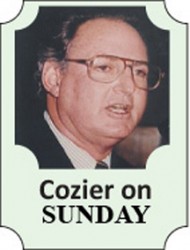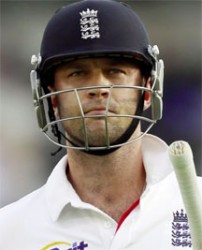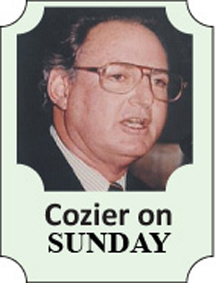Among the hundreds of analyses prompted by Jonathan Trott’s troubled exit from the Ashes series, interesting angles were advanced by two Mikes, Atherton and Selvey, both former England players now perceptive observers of the game in print and on TV and radio.
As with all the others appearing on the internet, bar none, both were suitably sympathetic to the mental problems that ended Trott’s tour. He is the latest of several cricketers to crack under the stress-related illness to which those in the public eye – sportsmen, pop stars, politicians, business tycoons – are most susceptible.
A variety of reasons have been attributed to the decision of a batsman with nine Test hundreds and an average of 46 to drop out. The most prominent, and obvious, is the pressure created by the fiery bodyline aggression of left-armer Mitchell Johnson in the Brisbane Test.
Selvey, writing in the Guardian, wondered whether, as Trott’s condition was already known to management and given the pressure he would be under from Aussies seeking the avenge their three straight Ashes defeats, it was wise to send him on such a high-profile mission.
The signs were there in the summer when he was out for four ducks, three first ball, in 12 innings in Tests and ODIs against the Australians, averaging under 30.
Atherton, whose career was in somewhat less frenetic times, put forward a credible, if novel, theory on the effect of what he termed modern “micromanagement”.
He noted that England are now travelling through Australia with 36 support staff – team director, coaches for batting, bowling (fast and spin), wicket-keeping and fielding, physical trainers, analysts, a doctor, a psychologist, a performance enhancer, a physiotherapist, a strength and conditioning coach, a security manager, a media manager and others whose jobs are not as plainly defined.
 Every facet of the players’ lives is closely monitored, down to the food they must eat.
Every facet of the players’ lives is closely monitored, down to the food they must eat.
“It is an approach that has produced great success and made good players better, but…it is time perhaps to acknowledge that such an approach may have its casualties as well,” Atherton wrote in The Times. Trott is an example.
It was overkill. It spread to Australia under head coach Mickey Arthur so that players “lost the freedom and confidence to make decisions for themselves and play their own way”.
Darren Lehmann took over from Arthur and, as Atherton put it, stripped away “that nonsense” and placed the emphasis on enjoyment of the game.
Atherton used the words of celebrated Brazilian football coach Luiz Felipe Scolari to emphasise the point: “My priority is to ensure that the players feel more amateur than professional. Thirty to 40 years ago the effort was the other way around. Now there is so much professionalism we have to revert to urging players to like the game, to love it, to do it with joy.”
It is a philosophy that has value. The trick is getting the balance right.
In 1950, another Cozier (my father to be precise) wrote of those who then administered the West Indies Cricket Board of Control (the ‘control’ was appropriately deleted four decades later): “They unfortunately have not been blessed with the brains vouchsafed to ordinary mortals but move in their own mysterious ways their blunders to perform”.
Covering the game regionally and for the West Indies press on the triumphant 1950 tour of England, Jimmy Cozier had ample experience of the WICBC’s “mysterious ways”.
While the game has changed dramatically, as has the profile of those who run it, the administration remains constant in its capacity to confuse and confound.
The board’s latest blunders involve the scheduling of two official matches for the West Indies team at venues continents apart, compounded by its inability, a week after he was chosen as a replacement for the injured Chris Gayle, to get young opener Kraigg Brathwaite from Barbados to New Zealand for a Test series that starts day after tomorrow.
In the first instance, the third and last ODI of their fleeting, hurriedly arranged tour of India in the hot, humid, teeming city of Kanpur and the start of the opening three-day fixture in New Zealand 8,000 miles south in chilly, sparsely populated Christchurch were both clearly, and mysteriously, listed on the respective itineraries for last Wednesday, November 27.
A time machine remains in the realms of science fiction. For now, it is impossible to be in the same place at the same time, a certainty not apparently evident to planners at the WICB.
The rushed Indian trip was devoted entirely to India’s superhero, Sachin Tendulkar; the two Tests allowed him to simultaneously chalk up his 200th Test in his native city and retire after a career of 24 years. The reason for the ODIs that followed was less obvious unless it was (excuse me for even thinking it) strictly a money-making exercise.
Since seven of those engaged in Kanpur, playing or as reserves, were also selected for the three Tests in New Zealand, it was obvious the West Indies could not raise a quorum for its advertised warm-up (in every sense) against a New Zealand XI in Christchurch.
They were further depleted by Shane Shillingford’s appointment in Perth for the ICC inspection of his bowling action and the delay over Brathwaite who remained stuck in Barbados up to yesterday, a week after his selection.
The WICB’s explanation was that it was awaiting the relevant visas for Australia (where Brathwaite would intransit) and New Zealand. The long wait reflected its lack of initiative and influence; a quick telephone call to the High Commissions was surely all that was needed have the process expedited.
It left recently appointed assistant coach Stuart Williams, the only management official on the ground, with Kirk Edwards, Shivnarine Chanderpaul, Chadwick Walton, Sheldon Cottrell and Shannon Gabriel as the only West Indians at his disposal. His first task was to seek six recruits from New Zealand Cricket to fill in the blank spaces.
As it is, those who flew in to Dunedin from India on Friday, after a back-to-front route that carried them to Dubai, Bangkok, Sydney and Christchurch and took 30 hours, had just three days to shake off jet-leg and tune up with a few net sessions before fronting up for the Dunedin Test in an environment far removed from what they had encountered over the previous month.
It was uncertain whether Brathwaite would ever get there.

Had the WICB not been responsible, it was all scarcely believable. Such chaos is not new; this was a throwback to the muddle over the switch from Tests to ODIs on the England tour in 2007.
A week after they were chosen, the WICB still couldn’t dispatch the ODI specialists in time for a one-day tune-up against the England ‘A’ team, the Lions. West Indians engaged in league or university cricket were drafted in; at least they were West Indians.
In his first series as captain, Gayle complained on the internet: “They want the best out of players but we also need the best out of the board”.
Darren Sammy would be advised not to comment this time; Gayle was immediately reprimanded.










